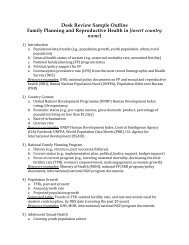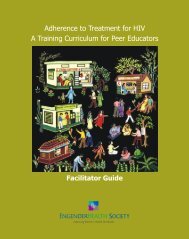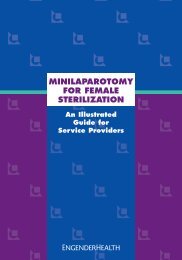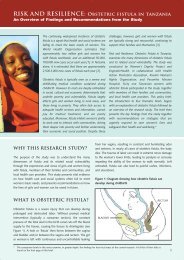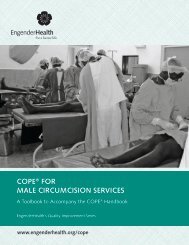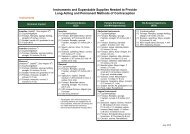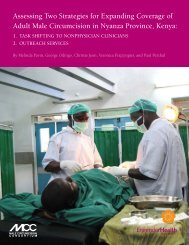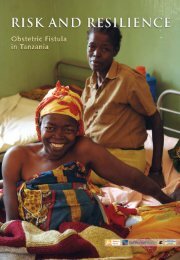Help-Seeking Pathways and Barriers for ... - EngenderHealth
Help-Seeking Pathways and Barriers for ... - EngenderHealth
Help-Seeking Pathways and Barriers for ... - EngenderHealth
Create successful ePaper yourself
Turn your PDF publications into a flip-book with our unique Google optimized e-Paper software.
1. Role <strong>and</strong> responsibilities:<br />
a. Would you please describe your current role <strong>and</strong> responsibilities<br />
b. How is your work related to GBV service provision <strong>and</strong> programming<br />
c. Do you collaborate with any partners in this work<br />
2. GBV services in the district/community<br />
a. What sources of support are there in this district/community <strong>for</strong> people who have<br />
experienced violence, including medical care <strong>and</strong> other support services<br />
i. Are there health clinics Where<br />
ii. Are there sources of psychological support Where (Probe <strong>for</strong> NGOs,<br />
CBOs, church-based groups, support groups, shelters/safe houses, etc.)<br />
iii. Are there sources of social support Where (Probe <strong>for</strong> NGOs, CBOs,<br />
church-based groups, support groups, shelters/safe houses, etc.)<br />
iv. Are there sources of legal support Where (Probe <strong>for</strong> police <strong>and</strong> criminal<br />
justice structures, NGOs, CBOs, paralegals, church-based groups, support<br />
groups, etc.)<br />
b. In addition to these <strong>for</strong>mal support structures, are there people or places that<br />
also provide support to people who have experienced gender-based violence<br />
i. Do they seek support from community leaders Which leaders<br />
ii. Do they seek support from community elders Who are these elders<br />
iii. Do they seek support from family <strong>and</strong> friends From whom<br />
3. <strong>Barriers</strong> to help-seeking<br />
a. In your opinion, what percentage of people who experience gender-based<br />
violence seek help<br />
i. From <strong>for</strong>mal sources of support (probe using <strong>for</strong>mal support service<br />
described in 2.a above)<br />
ii. From in<strong>for</strong>mal sources of support (probe using in<strong>for</strong>mal support services<br />
described in 2.b above)<br />
iii. Seek no support after experiencing gender-based violence<br />
b. What are the main reasons that more people don’t seek help<br />
i. From <strong>for</strong>mal sources of support<br />
ii. From in<strong>for</strong>mal sources of support Probe <strong>for</strong> interpersonal barriers (fear of<br />
stigma, fear of a partner, fear of renewed violence, embarrassment, etc.);<br />
structural barriers (transport issues, lack of service availability, the<br />
reputation of providers/sites); <strong>and</strong> resource-related barriers (cost of<br />
services, lack of childcare, etc.)<br />
<strong>Help</strong>-<strong>Seeking</strong> <strong>Pathways</strong> <strong>and</strong> <strong>Barriers</strong> <strong>for</strong> Survivors of GBV in Tanzania March 2013<br />
Page 68




